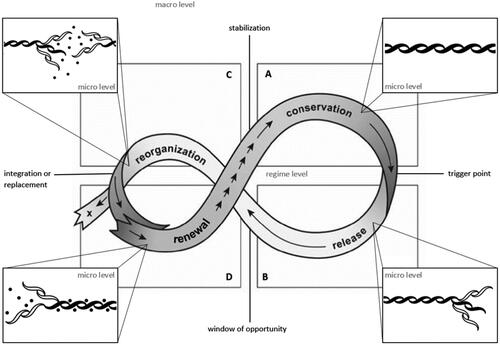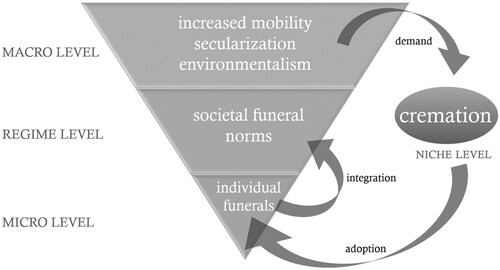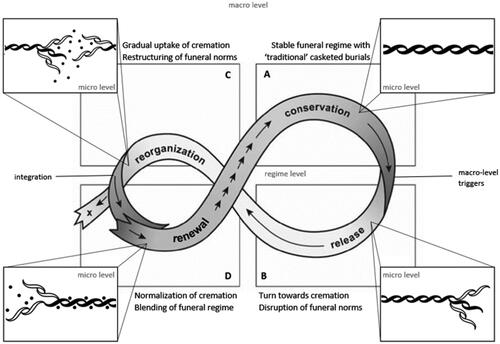Figures & data
Table 1. Potential impacts on human health and the environment associated with conventional and eco-friendly funeral practices.
Table 2. Nested levels in the death system.
Figure 1. Dynamics of change and stability in the death system (adapted from Gunderson and Holling Citation2002, 34). Note: In this model, the funeral regime undergoes various phases of transition, shaped both by the micro-level practices which constitute the regime, and by the macro-level environment in which it exists. Block A shows the funeral regime in a stable conservation phase, held intact by the continuous flow of conventional funeral practices at the micro level. In Block B, the regime is disrupted by macro- and/or micro-level events, causing societal funeral practices to fray, and opening a window of opportunity for alternative practices to flourish. During the reorganization phase (Block C), the regime is temporarily or permanently restructured, potentially integrating niche (non-mainstream) practices into the system. Block D illustrates the renewal process, in which the revised regime is reinforced and stabilized, either as a total replacement of the former regime or as a blended regime that combines old and new elements.

Figure 2. Integration of cremation into the funeral regime. Note: This figure illustrates the multilevel process by which a (formerly) niche practice was gradually integrated into societal funeral norms. A changing socio-cultural milieu at the macro level led to increased demand for cremation, which had long remained a niche practice outside of mainstream culture. Widespread adoption of cremation at the micro level then gradually shifted funeral norms, eventually integrating cremation into the funeral regime.

Figure 3. Regime shift from “traditional” ground burials to cremation (adapted from Gunderson and Holling Citation2002, 34). Note: This model illustrates the transition from a stable funeral regime based on “traditional” casketed burials to a blended regime of casketed burials and cremation. For decades, the “traditional” funeral regime remained stable (Block A) until it was disrupted by societal changes (Block B), allowing the practice of cremation to flourish. As cremation continued to spread, it became incorporated into funeral norms (Block C). Finally, with increasing normalization of cremation, the practice paralleled (and eventually overtook) casketed burials, leading to a renewed funeral regime (Block D). In the future, the regime is expected to continue tilting toward cremation, which may eventually lead to a replacement regime, rather than the current blended regime.

Figure 4. Feedback loop of eco-funeral normalization. Note: As eco-funerals are adopted by an expanding network of individuals at the micro level, these practices become more normalized in society. The gradual integration of these niche practices into mainstream society drives a shift in funeral norms. This shift in norms then amplifies the diffusion of eco-funerals, further normalizing and integrating these practices in society, thereby creating a positive feedback loop.

